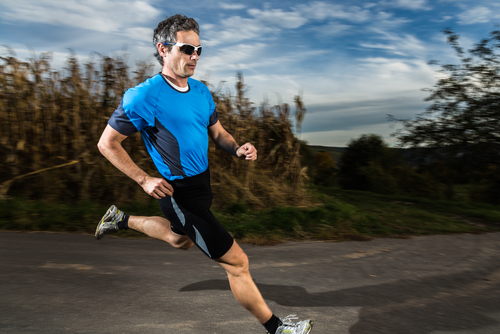Many runners suffer from sore iliotibial bands, also simply called the ITBs. Each ITB is a thick band of fascia that connects the outside of the knee to the outside of the pelvis, running over the hip and knee joints. As the leg swings during running, the band moves from behind the femur to in front of the femur. Thus, one suggestion on the cause of ITB syndrome is that the continual rubbing of the band over the lower femoral epicondyle combined with the repeated flexion and extension of the knee during running may cause inflammation.
How to Know if You Have ITB Syndrome
When the leg is straight, the fascia lies in front of the bony area at the outside of the knee, but as the knee bends it begins to move towards that bony point. At roughly thirty degrees of knee flexion, the fascia may make contact with that point. Typically a runner who is experiencing ITB syndrome will be unable to run due to extreme pain on the upper outside of the knee, but may well be able to walk or even perform other activities. Notably, walking downstairs can trigger it.
This also means that if you are borderline for ITB syndrome, as in you suspect that it is likely to flare up, that you should minimize downhill running as that can also be known to bring it on. Once pain has surfaced, usually the runner is unable to continue running at all. Because of the way downhil l work affects ITB issues, it is possible that you may still be able to run provided you do so on an incline, or indoors on a treadmill set to an incline.
Because the pain is often not present when not running, athletes will often avoid seeing a doctor. A good doctor will often test you for ITB syndrome by simply asking you to go for a run until pain is present and then making note of where the pain is, making diagnosis easy.
The Causes of ITB Problems
ITB issues can often be brought on by a shoe change, perhaps made to remedy a different problem. It is not uncommon for someone to have bought a new pair of stiffer shoes to fix a problem lower down in the feet, to return to the doctor not long after with ITB issues. Running expert Tim Noakes makes the recommendation that injured runners should resist the initial temptation to immediately go and buy new shoes.
ITB problems seem far more likely in less experienced runners. In 1995, a study published in Medicine & Science in Sports & Exercise found that runners who had higher training mileages, meaning they were also likely running slower, as well as those who swam were far more likely to suffer from this problem. Triathletes then are at the greatest risk for ITB syndrome as they are usually less skilled runners and will spend a lot of time swimming. It’s very important then that triathletes have a quality focused run training plan to offset the potential for this condition arising.
Interestingly, ITB syndrome seems to pop up most as inexperienced runners start increase their mileage close to a big race. The time frame seems to be within two or three months of the key event. It is even more likely if the long run is longer – up to two or three times as long – as the single longest other run during the week.

How to Deal With ITB Problems
ITB issues, if caught early enough, can be dealt with quite easily. As an example, in a 1993 study, the United States Marine Corps found that total immobilization of the affected leg (via bracing at the knee to keep it extended) and the use of crutches for three days effectively cured almost all acute ITB syndromes. Once the initial pain had disappeared after the three days, Marines were told to continue running, but only until the moment they felt pain outside the knee, at which point they were to stop. They were encouraged to use ice and anti-inflammatories to alleviate the pain. Following this regime the authors of the study found a 99% success rate in more than 2,000 injured Marines. The moral is clear – complete immobilization and un-weighting of the leg for three days can nearly guarantee fixing this issue as long as it is accompanied by a gradual rebuilding process.
Hopefully, you can see why most people’s trusted foam roller does little to help with this condition. Fascia is a fairly tough substance, being made from the same type of tissue that our ligaments and tendons are made of. As tough as connective tissue is, a foam roller will do little to fix your injury. At best you can hope for a temporary alleviation of the pain, but you won’t have fixed the problem.
ITB issues may be the easiest of all running related injuries to fix. Research shows that nearly 100% of patients can be fixed within a time frame of six weeks to six months. Those in the longer group would have been cured much faster had immobilization and the use of anti-inflammatories been used.
The Biomechanics Behind Onset of ITB Syndrome in Runners
The sudden addition of volume or intensity is always one of the possible contributors to injury. But some problems, like ITB issues, can also be a result of poor biomechanics. In addition to the increased mileage, a large part of the cause of ITB syndrome is muscle imbalances in the hips. I’ve always felt the best way to describe it is that if the muscles at the hip are too weak and have too much slack in them, then the ITB will take on the tension those muscles should have, and then next thing you know your ITB is pulling on your knee. But it could just as easily be hips that are overly tight and need stretching, too.
The control of the hip may also not be up to par – a common problem with many distance athletes – and the resulting collapse can put the body into a position it shouldn’t be in. This is exaggerated with running because of the thousands of reps per side that are possible per session. The issue can be exacerbated in multi sport athletes because cycling is often the root cause, and the same mechanical faults can be seen in their pedal stroke, which can again be magnified many thousand times even in just a short ride.
A great example of this was Lance Armstrong. During his reign of victories in the Tour De France, his team was aware of a slight inconsistency with his pedal stroke. But there was no need to correct it because at the end of each day he would stop all activity, get off his bike, and hop straight onto the massage table to have it fixed up. But when he started becoming interested in triathlon again, particularly the longer races, this small issue needed addressing so that he could run well. So if you’re a multi-sport athlete and have ITB issues, it is well worth your time to check bike position, cleat position, riding mechanics, and volume and intensity, as they may also be the culprit for your ITB problem.
Which Came First? The Knee or the ITB?
The knee and the ITB can be a bit of a chicken and the egg problem. Valgus collapse at the knee can be caused by weak feet, allowing for excessive pronation. But it can also be caused by weak hip rotators allowing internal rotation of the femur, too. Sometimes it is difficult to tell if the problem is occurring up- or downstream of the symptom.
The problem at the hip can also manifest in another way that is not as obvious. In good runners, the feet are not placed in line with each other when striking the ground. Imagine running along a painted line, like the lines on a tennis court. Good runners will run with each foot hitting the line, but not crossing over the line, nor fully covering it. Basically, they’ll hit the outside of the line on each step, with the left foot touching the left side of the line and the right foot touching the right side of the line.

A poor runner will run almost as if on a tight rope, with the feet both landing on that line. This is precipitated by the athlete undergoing increased hip adduction (movement of the thigh towards the midline) on the paw-back portion of the movement. As the rear leg crosses over the midline, it forces the front foot into this position. As the foot lands crossing over the midline, we see a contralateral pelvic drop. Interestingly, one of the world’s leading run physiotherapists, Brad Neal, says that, “The tension within the ITB will only increase when the origin and/or insertion are moved further apart.” When you combine a landing position with the front foot passing over the midline with this contralateral pelvic drop, you do exactly that, thereby increasing strain on the ITB.
Treatment for the pain should still remain the same, and I cannot urge you strongly enough to go with the Marine Corps method of full immobilization for three days. In addition, some time spent with a running coach or performing video analysis would be time well spent, as without fixing the mechanical error causing the issue, you will only end up suffering from it again.
References:
1. Noakes, T., Lore of Running (Champaign, IL: Human Kinetics, 2001)
2. Messier SP1, Edwards DG, Martin DF, Lowery RB, Cannon DW, James MK, Curl WW, Read HM Jr, Hunter DM., “Etiology of iliotibial band friction syndrome in distance runners.” Med Sci Sports Exerc. 1995 Jul;27(7):951-60.3.
3. Aronen JG, Chronister R, Regan K, et al. “Practical, conservative management of iliotibial band syndrome.” Phys Sportsmed 1993; 21(6): 59–69.
Photos courtesy of Shutterstock.






